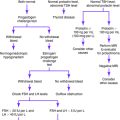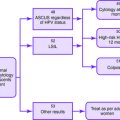Chapter 40 VAGINAL BLEEDING IN MIDDLE TO LATE PREGNANCY
The three main causes of vaginal bleeding in the second half of pregnancy are placenta previa, placental abruption, and preterm labor. Placenta previa is painless, whereas placental abruption and preterm labor are characterized by abdominal pain and uterine contractions.
Key Historical Features
✓ Nature and amount of bleeding
✓ Presence or absence of fetal movement
✓ Loss of fluid, rupture of membranes, or both
✓ Trauma (abdominal or vaginal)
✓ Previous pregnancies and any complications, including prior placental abruptions, premature labor, or preeclampsia
✓ Previous ultrasound examinations during current pregnancy
✓ Associated pelvic, abdominal, or lower back pain, which may indicate preterm labor, labor, placental abruption, uterine rupture, pelvic inflammatory disease, or preeclampsia
✓ History of any obstetric/gynecologic surgeries or procedures, including prior cesarean sections
✓ History of any sexually transmitted diseases or pelvic inflammatory disease
✓ Medical history, especially history of bleeding disorders, thrombophilia, or hypertension
Key Physical Findings
✓ Vital signs, including orthostatic assessments
✓ General evaluation of well-being
✓ If placenta previa is considered in the differential diagnosis, then ultrasonography should be performed to evaluate for placental location before a digital or speculum examination is performed, in order to prevent catastrophic bleeding
✓ If premature rupture of membranes is suspected, digital examination should be deferred until the speculum examination is performed, to evaluate for vaginal pooling
✓ If preterm labor is suspected, a test for fetal fibronectin should be performed before a digital examination
✓ Gynecologic/obstetric examination
✓ Abdominal examination for tenderness
✓ Rectal examination for hemorrhoids
✓ Skin examination for evidence of bruising, which may indicate a bleeding disorder, trauma, or abuse
Suggested Work-Up
| Abdominal or transvaginal ultrasonography | To evaluate for abruption, to locate the placenta, to calculate the amniotic fluid index, to determine fetal presentation, and to determine the gestational age of the fetus |
| Fetal heart monitoring | To evaluate fetal well-being |
| External tocodynamometry | To evaluate for uterine contractions |
| Blood type and screen | To determine the patient’s Rh status (if the patient is Rh negative, she should receive anti-D immune globulin) |
| Complete blood cell count (CBC) | To evaluate for anemia |
Additional Work-Up
| Wet-mount preparation and potassium hydroxide (KOH) microscopy of vaginal discharge | To evaluate for clue cells (bacterial vaginosis), hyphae (Candida infection), or Trichomonas infection |
| Group B Streptococcus culture | To evaluate for vaginal infection with group B streptococci so that prophylactic antibiotics can be administered if needed |
| Nitrazine test | If rupture of membranes is suspected (amniotic fluid is alkaline, turning nitrazine paper blue) |
| Fern test | If rupture of membranes is suspected (amniotic fluid, if left to dry on a slide, will have a “fern pattern”) |
| Fetal fibronectin measurement | To evaluate the risk for preterm labor |
| Liver function tests, CBC, prothrombin (PT) measurement, partial thromboplastin time (PTT) measurement, assessment of fibrin split products, serum creatinine measurement, uric acid measurement, 24-hour urine measurement for creatinine clearance and protein | If preeclampsia is suspected |
| Betke-Kleihauer test, CBC, PT measurement, PTT measurement, assessment of fibrin split products, and fibrinogen measurement | If placental abruption is suspected |
| Urinalysis and urine culture | To evaluate for urinary tract infection (if preterm labor is suspected) |
| Cervical culture for Neisseria gonorrhoeae and Chlamydia organisms | If the patient is at risk for a sexually transmitted disease |
| Drug screen | If cocaine use is suspected as a cause of placental abruption |
| Pap smear | If cervical neoplasia is suspected or if the patient is due for cervical cancer screening |
Beckmann CRB, Ling FW, Smith RP, et al, editors. Obstetrics and Gynecology, 5th, Philadelphia: Lippincott Williams & Wilkins, 2006.
McKennett M, Fullerton JT. Vaginal bleeding in pregnancy. Am Fam Physician. 1995;51:639-646.
Oyelese Y, Ananth CV. Placental abruption. Obstet Gynecol. 2006;108:1005-1016.
Oyelese Y, Smulian J. Placenta previa, placenta accrete and vasa previa. Obstetr Gynecol. 2006;107:927-941.
Toppenberg KS, Block WA. Uterine rupture: what family physicians need to know. Am Fam Physician. 2002;66:823-828.




